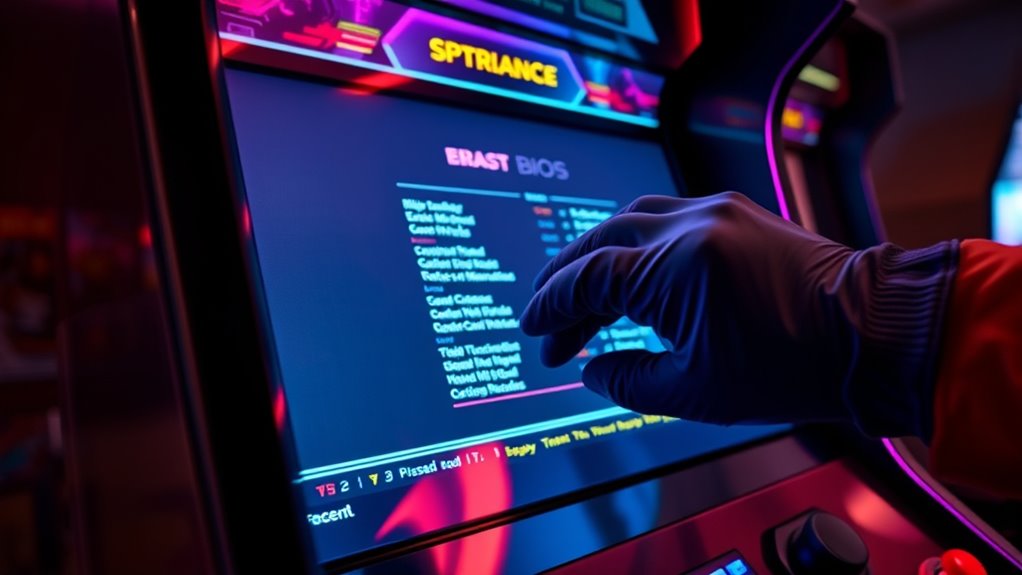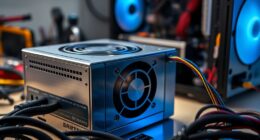When upgrading your arcade firmware, make certain you download the correct version from the official source and verify it matches your hardware model. Before proceeding, back up your current BIOS to prevent data loss. Follow the specific update steps carefully, avoiding interruptions, and then check and adjust BIOS settings for peak performance. Staying cautious throughout this process helps prevent issues; if you explore further, you’ll discover detailed tips to make the upgrade smoother.
Key Takeaways
- Verify firmware compatibility with your specific arcade hardware model before proceeding.
- Create a BIOS backup by saving the current BIOS to external storage as a safety measure.
- Download firmware only from official sources and follow the provided update instructions carefully.
- Transfer firmware to a USB drive and ensure no power interruptions during the update process.
- After updating, review and adjust BIOS settings for optimal performance and hardware compatibility.

Upgrading your arcade firmware and adjusting BIOS settings are essential steps to guarantee peak performance, stability, and compatibility of your arcade machine. When tackling firmware updates, you need to verify firmware compatibility. Not all firmware versions work seamlessly with every arcade hardware, so confirming that the update matches your specific model is fundamental. Mismatched firmware can lead to system crashes, input issues, or even hardware damage. Before you proceed, check official manufacturer documentation or support forums to confirm that the firmware update is suitable for your arcade setup. This prevents potential headaches and keeps your system running smoothly.
Another critical preventative measure is creating a BIOS backup. A BIOS backup acts as a safety net, allowing you to restore your system to its original state if the new firmware causes issues. To do this, you typically access your BIOS setup during startup, then save the current BIOS to an external drive or a USB stick. Having this backup ensures you won’t be stranded if the update goes wrong, especially if you encounter boot failures or system instability. It’s a straightforward step that saves time and frustration later on, so don’t skip it.
When you’re ready to update, follow a reliable procedure. Download the firmware update directly from the manufacturer’s official site to avoid corrupted or malicious files. Carefully read all instructions before starting—many updates involve specific steps like formatting a USB drive or entering BIOS in a particular way. Once you have the correct firmware file, transfer it to your storage device and follow the update process precisely. During the update, avoid interrupting power or turning off the machine, as this can brick your arcade system. Additionally, verifying firmware compatibility ensures that the update will function correctly with your hardware, reducing the risk of issues.
Adjusting BIOS settings after the update may also be necessary. Firmware updates sometimes reset BIOS configurations, so double-check your settings for peak performance. Tweak options such as boot order, display settings, or memory timings if needed. Keep in mind that some BIOS adjustments can improve stability or compatibility with newer firmware. If you’re unsure about specific settings, consult your arcade hardware manual or online guides tailored for your model.
Throughout this process, patience and attention to detail are key. Updating firmware and managing BIOS settings might seem technical, but following proper procedures minimizes risks. Always prioritize backing up your BIOS and verifying firmware compatibility. These steps safeguard your arcade machine, ensuring it delivers reliable performance and long-term stability, letting you enjoy your gaming setup with confidence.
Frequently Asked Questions
How Do I Backup My Current Arcade Firmware Before Upgrading?
To backup your current arcade firmware, you need to perform a firmware backup to guarantee firmware preservation. Use a specialized tool or software recommended by your arcade’s manufacturer to create a full image of the current firmware. Save this backup file on a secure external drive or cloud storage. This way, you can easily restore your firmware if anything goes wrong during the upgrade, avoiding potential data loss or system issues.
What Are Common Troubleshooting Steps After a Failed Firmware Update?
If your firmware update fails, start by performing a firmware rollback to restore your system to a stable state. Check all connections to guarantee hardware safety, then restart your arcade system. If issues persist, reflash the firmware or consult the manufacturer’s troubleshooting guide. Always prioritize hardware safety during this process, and consider testing with a backup firmware version to prevent further complications.
Can I Revert to a Previous BIOS Version if Issues Arise?
If issues arise after a BIOS update, you can perform a BIOS rollback by reverting to a previous version. For example, a user faced system instability after a firmware reversion and successfully restored stability by flashing an earlier BIOS. This process involves using BIOS rollback tools or firmware reversion options provided by your motherboard or arcade system manufacturer. Always verify you have the correct BIOS version before proceeding to avoid further complications.
Are There Risks of Damaging Hardware During Firmware Upgrades?
Yes, there are hardware risks during firmware upgrades, but they’re generally mitigated if you follow proper procedures. You might encounter issues like power loss or interruptions, which could damage your hardware. To guarantee firmware safety, always use official updates, keep your device powered during the process, and avoid interruptions. Staying cautious helps prevent hardware risks and ensures a smooth upgrade without risking your arcade system’s integrity.
How Often Should I Update My Arcade BIOS and Firmware?
You should update your arcade BIOS and firmware only when necessary, following a careful update schedule. Coincidentally, timely updates can extend firmware longevity and improve system stability. Don’t rush into updates; instead, monitor official releases and only upgrade if you encounter issues or new features that benefit your setup. Regular check-ins guarantee your system stays current without risking unnecessary hardware problems, balancing performance and safety seamlessly.
Conclusion
Upgrading your arcade firmware and BIOS settings is like giving your machine a shot of fresh energy, keeping it running smoothly and securely. By staying current, you prevent glitches and unseal new features, turning your arcade into a well-oiled gaming machine. Remember, it’s a small step that makes a big difference—think of it as tuning your engine for peak performance. Keep your system updated, and enjoy seamless, high-quality gaming experiences every time.








